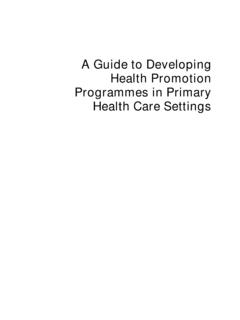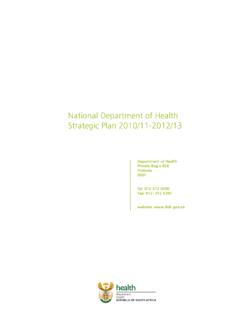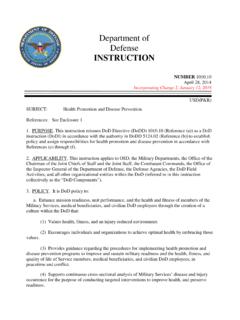Transcription of Chronic Obstructive Pulmonary Disease Public …
1 Public health strategic framework for copd Prevention National Center for Chronic Disease Prevention and health promotion Division of Adult and Community health Suggested Citation: Centers for Disease Control and Prevention. Public health strategic framework for copd Prevention. Atlanta, GA: Centers for Disease Control and Prevention; 2011. Available at Disclaimer: The findings and conclusions in this report are those of the authors and do not necessarily represent the official position of the Centers for Disease Control and Prevention. Introduction In the spring of 2010, the Centers for Disease Control and Prevention (CDC) and several partners embarked on an intensive process to examine the current state of knowledge regarding Chronic Obstructive Pulmonary Disease ( copd ) prevention.
2 The process included identifying Public health gaps and generating a set of goals that would define the unique role and contributions of Public health in the prevention and control of copd . This workgroup represented other federal agencies, academia, the health care sector, national organizations, and other copd stakeholders. The purpose of this report is to provide a framework that could be used by the Public health community to address copd as an important Public health issue. Background Approximately, 12 million Americans have been diagnosed with copd , but at least another 12 million Americans may be undiagnosed (1). copd refers to a group of Chronic diseases, including emphysema and Chronic bronchitis, that impair the flow of air in the lungs and make breathing difficult.
3 While copd death rates are higher among men than women, over the past 20 years, the number of copd deaths among women has increased much faster than those among men (1 3). copd death rates are also higher among whites than among African Americans or persons of other races (1 3), and in some states, including Idaho and Indiana (3). In addition, women had more copd hospitalizations than men and more emergency department visits (1,2,4). Prevention Approximately 75% of copd cases are attributed to cigarette smoking (5). Occupation-related exposures may account for another 15% of copd cases (6) and genetic factors, asthma, respiratory infections, and indoor and outdoor exposures to air pollutants also play a role (6,7).
4 Thus, copd largely can be prevented. Prevention of copd begins with reducing and/ or eliminating smoking initiation among teenagers and young adults and encouraging tobacco cessation among current smokers. More than 20 million workers in the United States have been exposed to gases, vapors, fumes, and dusts that may cause copd (6). Public health programs and policies that focus on tobacco-use prevention and cessation, reducing occupational exposure to dusts and chemicals, and reducing other indoor and outdoor air pollutants are critically important. Early treatment and control of asthma may also prevent the development of copd . 1 Diagnosis Common symptoms of copd include shortness of breath, cough, phlegm, and wheezing.
5 As many as one-half of all persons with symptoms of copd have not been diagnosed because these signs are often attributed to aging or normal smoker s symptoms. A definitive diagnosis of copd involves measuring lung function using spirometry, which is a noninvasive outpatient procedure. Treatment Once copd has been diagnosed, goals of treatment and management include relieving symptoms; preventing and treating Disease progression, complications, and exacerbations; improving exercise tolerance, daily activity, and health status; monitoring nutritional needs; and reducing premature mortality (8). Management should include smoking cessation and abstinence; limiting exposure to secondhand smoke, dusts, fumes, and gases; pharmacological treatment with bronchodilators and corticosteroids; supplemental oxygen therapy; Pulmonary rehabilitation; collaborative self-management; and surgery (8).
6 Clearly, efforts toward patient and professional education should continue to focus on promoting treatment modalities for persons with copd as well as persons at risk for copd . Public health Goals The workgroup identified four goals that were grounded in the following Public health areas: (1) surveillance and evaluation: improve collection, analysis, dissemination, and reporting of copd -related Public health data; (2) Public health research and prevention strategies: improve understanding of copd development, prevention, and treatment; (3) programs and policies: increase effective collaboration among stakeholders with copd -related interests; and (4) communication: heighten awareness of copd among a broad spectrum of stakeholders and decision makers (Table 1).
7 To accomplish these goals, the workgroup proposed the following objectives, strategies, and actions based on a detailed, scientific rationale. 2 Goal 1: Surveillance and Evaluation Improve collection, analysis, dissemination, and reporting of copd -related Public health data. Objectives Adapt and expand current national population-based surveillance systems such as the Behavioral Risk Factor Surveillance System (BRFSS, state-based, self-reported data), National health and Nutrition Examination Survey (NHANES, national data collection involving a combination of interviews, spirometry, and physical examinations), and the National health Interview Survey (NHIS, national, self-reported data) to include more copd -related information.
8 Adapt and expand current national health care surveillance systems ( health care system-based surveys) to include copd -related information. Analyze and report copd -relevant data from these surveys. Rationale Ongoing data collection is required to assess the nation s progress toward Healthy People 2020 copd objectives which includes: (1) Reduce activity limitations among adults with Chronic Obstructive Pulmonary Disease ( copd ); (2) Reduce deaths from Chronic Obstructive Pulmonary Disease ( copd ) among adults; (3) Reduce hospitalizations for Chronic Obstructive Pulmonary Disease ( copd ); and (4) (Developmental) Increase the proportion of adults with abnormal lung function whose underlying Obstructive Disease has been diagnosed.
9 Current population-based surveys already capture some information related to copd such as smoking prevalence, medical care utilization, and prevalence of Chronic health conditions. However, copd -related topics could be analyzed more extensively in current surveillance systems and new questions could be added to existing surveys. Due to the designs and periodic revisions of these surveys, adapting or adding new questions related to copd to existing surveys would be more time- and cost-efficient than creating new surveillance systems specifically focused on copd . 3 Strategy 1: Maximize use of currently available data. Potential actions include: Analyzing currently available data relevant to copd in existing surveys (BRFSS, NHANES, NHIS, etc.)
10 ; Publishing high profile CDC reports on copd -related topics; Developing a comprehensive report of information ( , surveillance summary) across surveys regarding copd every 4 years; Presenting information on current copd -related NHANES survey data addressing occupational risk factors. Strategy 2: Develop and initiate new data collection within existing surveys. Potential actions include: Adding new questions related to copd to existing surveys; Developing and testing new questions for reliability and validity, as needed; Refining the definition of copd in existing surveillance systems by adding the terms copd and Chronic Obstructive Pulmonary Disease to the currently used emphysema and Chronic bronchitis terms; Adding new questions on occupational and environmental exposures; Including new queries on genetics and family history; Inserting new questions related to asthma.

















